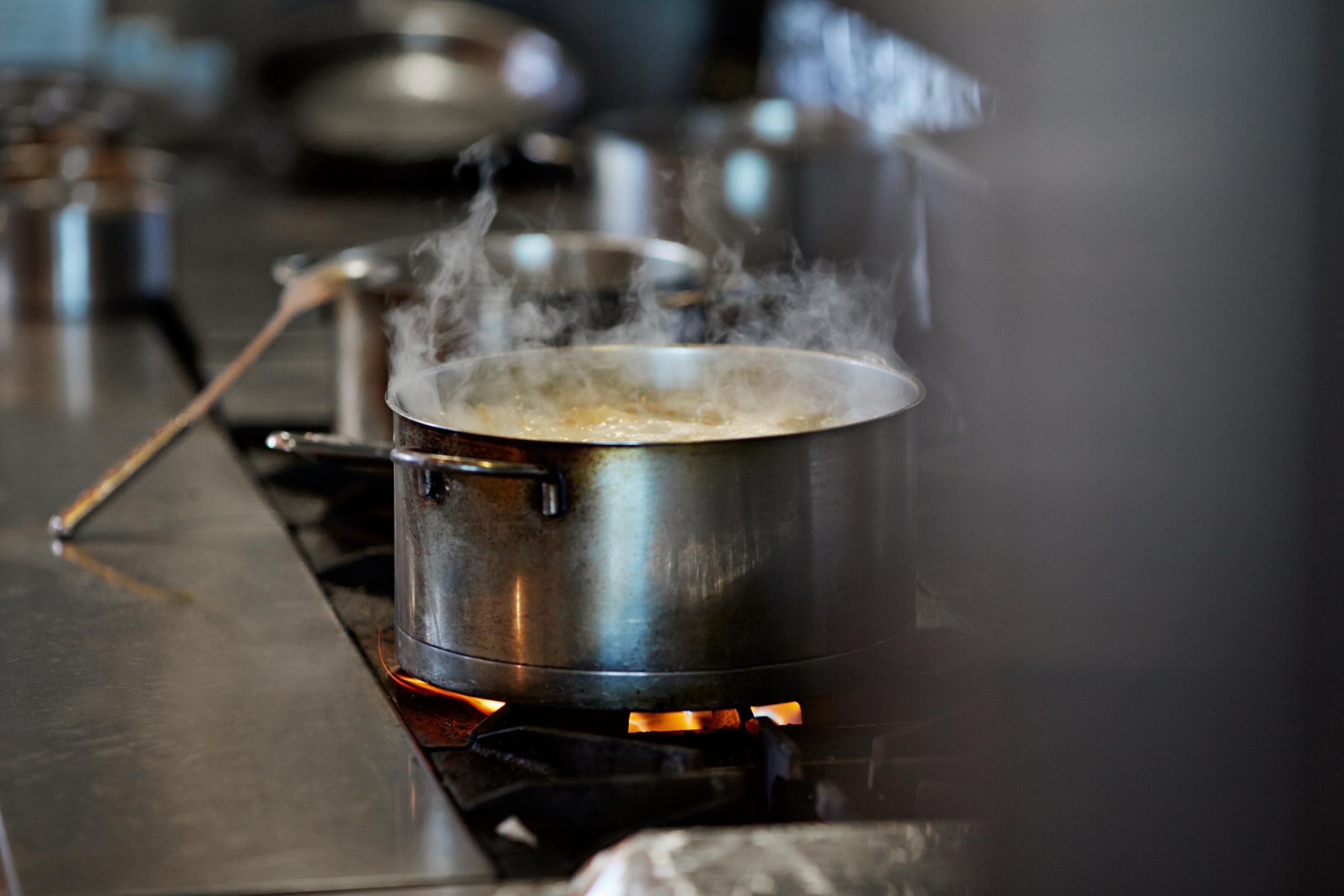Choosing the right foods is one part of eating healthy—but how you prepare them also plays a role. “Research shows that certain cooking methods may change the makeup of our food in ways that could potentially harm our health,” says Dr. Donald Hensrud, medical director of the Mayo Clinic Healthy Living Program. For instance, studies have suggested a link between eating excessive amounts of meat cooked at high temperatures and increased risks of colorectal and pancreatic cancers. No need to panic, though: “There’s a lot we still don’t fully understand, but we do know that some methods are better to use regularly and some are better saved for special occasions,” says Hensrud. Keep the following in mind as you fire up your next meal.
Here’s what you need to know about the healthfulness of popular cooking methods.
This article originally appeared on Health.com
Stir-frying and sautéing

The takeaway: It’s fine with the right oils and temperature.
These two styles are fast and versatile. The downside: Pan-frying requires heating oil at high temps, which may result in harmful by-products. For one, fumes released from overheating some cooking oils may contain compounds known as heterocyclic amines (HCAs) and polycyclic aromatic hydrocarbons (PAHs), which increase cancer risk, says Hensrud. What’s more: “When cooking oil gets heated to high temperatures, it oxidizes and releases free radicals that can cause further oxidation, which can lead to DNA mutations and inflammation in the body.” It’s worth noting that oxidation happens even without cooking. “Oxidation occurs over time when an oil gets rancid sitting at room temperature,” he says. “But the higher you heat an oil, the quicker it gets oxidized.”
Health.com: The Best Healthy Salsa Recipes
By no means do you have to nix your favorite stir-fry recipe from your weekly dinner rotation. You can healthy up a sautéed dish by keeping the cook time short to control oxidation and by using an oil with a higher smoke point to reduce fumes. “In general, an oil with a smoke point of 400 degrees Fahrenheit or greater is good,” says Hensrud. He recommends avocado oil, which has a smoke point of about 520 degrees, or peanut oil, with a smoke point of 450 degrees.
Overall, don’t stress about possible harm from a bit of hot oil. “If sautéing gets lots of vegetables and antioxidants into someone’s diet, that’s great,” says Hensrud. “We’ve got to keep things in perspective.”
Poaching

The takeaway: It’s safe (and underrated).
This moist-heat technique involves cooking at a gentle simmer in a liquid such as broth or water. Poaching is a healthy and underutilized way to cook, says Lauren Slayton, RD, founder of the nutrition consulting center Foodtrainers in New York City. “I poach wild salmon and chicken breasts for salads or any type of shredded preparation,” she says. If you’re poaching meat, know that you can’t tell meat is safely cooked by looking at it. Use a meat thermometer: Chicken should be cooked to 165 degrees Fahrenheit, while fresh beef and pork should reach an internal temp of 145.
And remember: If you’re poaching in something other than water—like milk or oil—you may be tacking on calories, points out Katie Morford, RD, creator of the food and nutrition blog Mom’s Kitchen Handbook.
Roasting

The takeaway: Balance roasting with other, healthier cooking modes, and don’t have french fries too frequently (but you knew that already).
Roasting starchy plant-based foods (like potatoes and bread) may pose a health risk when they’re cooked too dark. “Acrylamide, which we consider a probable human carcinogen, can form from a chemical reaction in foods that have the amino acid asparagine when they’re heated at high temperatures,” says Dr. Paolo Boffetta, associate director of the Tisch Cancer Institute at the Icahn School of Medicine at Mount Sinai in New York City. Potato chips and french fries have some of the highest levels of acrylamide, says Hensrud, but crispy oven-roasted potatoes also have a lot. The compound is believed to either not form or form at lower levels in fish, meat, and dairy, per the American Cancer Society.
Health.com: Salt-Free Cooking Tricks to Make Food Taste Better
You probably can’t completely avoid acrylamide, and based on the studies done so far, it’s not clear if it actually affects cancer risk in people. If you are concerned, the ACS says you may reduce the amount by toasting bread to a light brown color or browning potatoes to a golden yellow (the darker the food is cooked, the more acrylamide is formed).
Steaming and boiling

The takeaway: These methods are both good go-tos.
Moist-heat cooking methods, such as boiling and steaming, are the healthiest ways to prepare meats and produce because they’re done at lower temperatures. And if you’re watching your weight, these styles are good for keeping calories down because they often don’t require oil or butter, points out Tricia Psota, PhD, a nutritionist at the USDA Center for Nutrition Policy and Promotion.
Health.com: Best and Worst Summer Foods
For vegetable preparation, steaming trumps boiling when it comes to hanging on to nutrients like carotenoids and phytochemicals, according to a large review of studies comparing cooking methods in International Journal of Gastronomy and Food Science. “Boiling can cause water-soluble nutrients—like vitamins B and C—to leach out into the water, but they’re retained with steaming,” explains Slayton.
Broiling

The takeaway: Stick to thin cuts of meat, which will have shorter cook times, and don’t make broiled meats your norm.
Broiling, or placing food below your oven’s heat source for a high-heat blast, could cause acrylamide to form. And you could char the food. Marinating meat in vinegar, lemon, or herbs like thyme and rosemary may act as a barrier against HCAs when broiling or grilling.
Grilling

The takeaway: It’s not ideal as a daily method but better for you when done the right way.
Just about anything (bacon! steak!) tastes better charred or crispy. But grilled meat has been associated with higher risks of certain cancers, says Boffetta. “Grilling meat forms HCAs and PAHs that may cause changes to DNA in the body that might lead to cancer,” he explains. (Researchers at the University of Minnesota School of Public Health found that people who ate very well-done steak were almost 60 percent more likely to get pancreatic cancer than those who ate steak less well-done or who didn’t eat steak at all.)
Health.com: The Healthiest Fruits for Your Body
You don’t have to give up grilled meat. “If you constantly eat lots of very well-done meat off the grill, could it conceivably increase your cancer risk? Maybe—but that is very difficult to prove in an individual,” notes Hensrud. “If you eat generally healthy, grilling once in a while is a small fraction of your diet and likely won’t have any great impact on your health.” Until the research is clearer, have grilled meats in moderation. The National Cancer Institute also recommends cutting away blackened pieces and flipping meats often (so that one side isn’t sitting on the flames or in the pan for prolonged periods) or pre-cooking meats in the microwave and finishing on the grill.
3 ways to make your veggies taste amazing

Prefer munching on your farmers’ market haul uncooked? Steal these RD hacks to pack more tang and zing into plain plants.
Dress them up. “The easiest healthy vegetable dip in the world is mashed avocado with lime juice and salt,” says Slayton. Or drizzle veggies with olive oil and an acid like lemon juice or apple cider vinegar, recommends Morford. Bonus: Studies have found that eating fresh vegetables with a healthy fat helps the body absorb nutrients in the plants.
Cheat a little. “For any vegetables that don’t wow you raw, blanch them,” says Slayton. What does that mean? “Take your asparagus or broccoli, for instance, and place in boiling water for a minute or less,” she explains. “Then transfer it to a bowl of water with ice to stop cooking at that perfect, bright place.”
Swap them out. Some people don’t love raw veggies because they’re thinking of the usual suspects, like carrots and broccoli. Morford suggests going with offbeat picks (jicama, radish, kohlrabi, fennel) to surprise the taste buds. Try pairing new-to-you veggies with a dip made from Greek yogurt, a splash of olive oil, a pinch of salt and black pepper, and herbs such as basil, mint, cilantro, or parsley.
More Must-Reads from TIME
- Inside Elon Musk’s War on Washington
- Meet the 2025 Women of the Year
- Why Do More Young Adults Have Cancer?
- Colman Domingo Leads With Radical Love
- 11 New Books to Read in Februar
- How to Get Better at Doing Things Alone
- Cecily Strong on Goober the Clown
- Column: The Rise of America’s Broligarchy
Contact us at letters@time.com